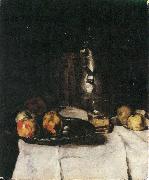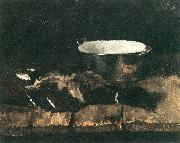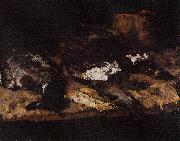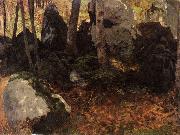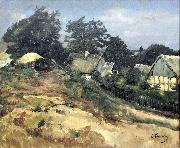Carl Schuch Oil Painting ReproductionAll Carl Schuch Oil Paintings(30 September 1846 - 13 September 1903) was an Austrian painter, born in Vienna, who spent most of his lifetime outside Austria, in Germany, Italy and France. He painted primarily still lifes and landscapes. During the period 1882-94 he was based in Paris, where he was greatly impressed by the work of Claude Monet whom he described as "the Rembrandt of plein-air painting" although he was attracted most of all to Rembrandt and the artists of the Barbizon school. In 1884 and 1885 he spent the summer months in the Netherlands, studying the Dutch old masters as well as the contemporary painters of the Hague School, and filling notebooks with detailed descriptions of the colors he observed in paintings that he admired. Of all the artists belonging to the circle around Wilhelm Leibl (called the Leibl-Kreis), Schuch was the most devoted to color. His work marks the transition from the realist tradition to the modern movement in Vienna, esthetically, however, it is far from contemporary trends, and from its means and ends, comparable to Paul Cezanne (Gottfried Boehm, referring to Arnold Gehlen). |
|||

|
|||
|
|
|||
|
||||||||
| Carl Schuch (30 September 1846 - 13 September 1903) was an Austrian painter, born in Vienna, who spent most of his lifetime outside Austria, in Germany, Italy and France. He painted primarily still lifes and landscapes. During the period 1882-94 he was based in Paris, where he was greatly impressed by the work of Claude Monet whom he described as "the Rembrandt of plein-air painting" although he was attracted most of all to Rembrandt and the artists of the Barbizon school. In 1884 and 1885 he spent the summer months in the Netherlands, studying the Dutch old masters as well as the contemporary painters of the Hague School, and filling notebooks with detailed descriptions of the colors he observed in paintings that he admired. Of all the artists belonging to the circle around Wilhelm Leibl (called the Leibl-Kreis), Schuch was the most devoted to color. His work marks the transition from the realist tradition to the modern movement in Vienna, esthetically, however, it is far from contemporary trends, and from its means and ends, comparable to Paul Cezanne (Gottfried Boehm, referring to Arnold Gehlen). |
||||||||
|
|
||||||||
| Gemälde IDENTIFIZIERUNG:: 96876 Zinnkrug 1877(1877) Medium oil on canvas Dimensions 61 X 51.5 cm (24 X 20.3 in) cyf |
||||||||
|
|
||||||||
| Gemälde IDENTIFIZIERUNG:: 96902 Wildente und Emailtopf oil on canvas Dimensions 58 X 73 cm cyf |
||||||||
|
|
||||||||
| Gemälde IDENTIFIZIERUNG:: 96903 Spankorb und Tontopf after 1888(1888) Medium oil on canvas Dimensions 64.5 X 80.5 cm cyf |
||||||||
|
|
||||||||
| Gemälde IDENTIFIZIERUNG:: 96985 Bemooste Felsblocke im Wald 1888 (?) Medium oil on canvas, doubliert Dimensions 62.5 X 82.7 cm cyf |
||||||||
|
|
||||||||
| Gemälde IDENTIFIZIERUNG:: 97259 Houses in Ferch by Lake Schwielow between 1878(1878) and 1881(1881) Medium oil on canvas Dimensions 70 X 84 cm cyf |
||||||||
|
|
||||||||
| VORHERIGER KÜNSTLER NÄCHSTER KÜNSTLER | ||||||||
|
|
||||||||
|
Carl Schuch (30 September 1846 - 13 September 1903) was an Austrian painter, born in Vienna, who spent most of his lifetime outside Austria, in Germany, Italy and France. He painted primarily still lifes and landscapes. During the period 1882-94 he was based in Paris, where he was greatly impressed by the work of Claude Monet whom he described as "the Rembrandt of plein-air painting" although he was attracted most of all to Rembrandt and the artists of the Barbizon school. In 1884 and 1885 he spent the summer months in the Netherlands, studying the Dutch old masters as well as the contemporary painters of the Hague School, and filling notebooks with detailed descriptions of the colors he observed in paintings that he admired. Of all the artists belonging to the circle around Wilhelm Leibl (called the Leibl-Kreis), Schuch was the most devoted to color. His work marks the transition from the realist tradition to the modern movement in Vienna, esthetically, however, it is far from contemporary trends, and from its means and ends, comparable to Paul Cezanne (Gottfried Boehm, referring to Arnold Gehlen). |
||||||||
|
|
||||||||
|
KONTAKTIEREN Sie UNS |





